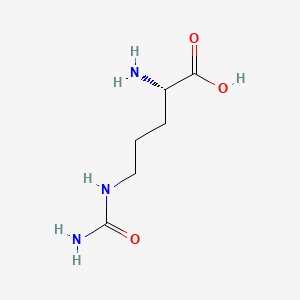



1. L-citrulline
2. 372-75-8
3. H-cit-oh
4. Delta-ureidonorvaline
5. Sitrulline
6. (s)-2-amino-5-ureidopentanoic Acid
7. N5-carbamoyl-l-ornithine
8. L-cytrulline
9. N(delta)-carbamylornithine
10. Citrulline, L-
11. N5-(aminocarbonyl)ornithine
12. L(+)-citrulline
13. Alpha-amino-delta-ureidovaleric Acid
14. L-2-amino-5-ureidovaleric Acid
15. N5-carbamoylornithine
16. Ornithine, N5-(aminocarbonyl)-
17. L-ornithine, N5-(aminocarbonyl)-
18. (2s)-2-amino-5-(carbamoylamino)pentanoic Acid
19. 2-amino-5-ureidovaleric Acid
20. N5-(aminocarbonyl)-l-ornithine
21. 29vt07bgda
22. L-citrullin
23. Chebi:16349
24. N(5)-(aminocarbonyl)-l-ornithine
25. Nsc-27425
26. D-ureidonorvaline
27. Mfcd00064397
28. N~5~-carbamoyl-l-ornithine
29. 2-amino-5-uredovaleric Acid
30. Cir
31. Ngamma-carbamylornithine
32. L-(+)-citrulline
33. L-citruline
34. (2s)-2-amino-5-(carbamoylamino)pentanoic Acid (citrulline)
35. Ornithine, N5-carbamoyl-, L- (8ci)
36. 94740-46-2
37. N5-carbamylornithine
38. Einecs 206-759-6
39. Nsc 27425
40. Unii-29vt07bgda
41. Cytrulline
42. Ureidonorvaline
43. Ureidovalerate
44. Ornithine, N5-carbamoyl-, L-
45. Gammaureidonorvaline
46. N-carbamylornithine
47. L-citrulline, 4
48. Amino-ureidovalerate
49. Nd-carbamylornithine
50. L-citrulline,(s)
51. L(+)-citrulline;
52. N()-carbamylornithine
53. L-citrulline (dcf)
54. Ndelta-carbamylornithine
55. Starbld0002494
56. Amino-ureidovaleric Acid
57. Ndelta-carbamy-ornithine
58. Citrulline [mi]
59. A-amino-d-ureidovalerate
60. 2-amino-5-uredovalerate
61. Citrulline [inci]
62. 2-amino-5-ureidovalerate
63. L-n5-carbamoyl-ornithine
64. Citrulline [vandf]
65. Bmse000032
66. Bmse000800
67. Bmse000858
68. Citrulline [mart.]
69. Citrulline [who-dd]
70. A-amino-d-ureidovaleric Acid
71. L-2-amino-5-ureidovalerate
72. N(5)-carbamoyl-l-ornithine
73. Schembl20588
74. Gtpl722
75. (2s)-2-amino-5-(aminocarbonylamino)pentanoic Acid
76. N5-(aminocarbonyl)-ornithine
77. L-2-amino-5-ureido-valerate
78. L-citrulline [usp-rs]
79. Chembl444814
80. Alpha-amino-delta-ureidovalerate
81. Alpha-amino-gamma-ureidovalerate
82. Schembl13254095
83. Bdbm92903
84. (s)-2-amino-5-ureidopentanoate
85. Dtxsid80883373
86. L(+)-2-amino-5-ureidovalerate
87. L-2-amino-5-ureido-valeric Acid
88. L-citrulline, >=98% (tlc)
89. Hy-n0391
90. Zinc1532614
91. L(+)-2-amino-5-ureidovaleric Acid
92. S3798
93. Akos005259571
94. Akos006240677
95. Am82461
96. Ccg-266398
97. Cs-w019940
98. Db00155
99. Smp1_000146
100. Ncgc00142602-01
101. Ac-23976
102. As-12594
103. (2s)-2-amino-5-(carbamoylamino)pentanoate
104. (s)-2-amino-5-(aminocarbonyl)aminopentanoate
105. N(sup 5)-(aminocarbonyl)-l-ornithine
106. C00327
107. D07706
108. D71216
109. M03230
110. (s)-2-amino-5-(aminocarbonyl)aminopentanoic Acid
111. 372c758
112. A823585
113. Q408641
114. W-202536
115. Ea65b21d-61c4-4748-9e9f-0cf6edf9a21d
116. L-citrulline, United States Pharmacopeia (usp) Reference Standard
| Molecular Weight | 175.19 g/mol |
|---|---|
| Molecular Formula | C6H13N3O3 |
| XLogP3 | -4.3 |
| Hydrogen Bond Donor Count | 4 |
| Hydrogen Bond Acceptor Count | 4 |
| Rotatable Bond Count | 5 |
| Exact Mass | 175.09569129 g/mol |
| Monoisotopic Mass | 175.09569129 g/mol |
| Topological Polar Surface Area | 118 Ų |
| Heavy Atom Count | 12 |
| Formal Charge | 0 |
| Complexity | 171 |
| Isotope Atom Count | 0 |
| Defined Atom Stereocenter Count | 1 |
| Undefined Atom Stereocenter Count | 0 |
| Defined Bond Stereocenter Count | 0 |
| Undefined Bond Stereocenter Count | 0 |
| Covalently Bonded Unit Count | 1 |
Used for nutritional supplementation, also for treating dietary shortage or imbalance.
A non-essential amino acid and a precursor of arginine. Citrulline supplements have been claimed to promote energy levels, stimulate the immune system and help detoxify ammonia (a cell toxin). L-citrulline is made from L-ornithine and carbamoyl phosphate in one of the central reactions in the urea cycle. It is also produced from L-arginine as a by-product of the reaction catalyzed by the enzyme NO synthase. L-citrulline, while being an amino acid, is not involved in protein synthesis and is not one of the amino acids coded for by DNA. Although citrulline cannot be incorporated in proteins during protein synthesis, several proteins are known to contain citrulline as an amino acid. These citrulline residues are generated by a family of enzymes called peptidylarginine deiminases (PADs), which convert the amino acid arginine into citrulline. Proteins that contain citrulline residues include myelin basic protein (MBP), fillagrin and several histone proteins.
L-citrulline is converted to L-arginine by argininosuccinate synthase. L-arginine is in turn responsible for citrulline's therapeutic affects. Many of L-arginine's activities, including its possible anti-atherogenic actions, may be accounted for by its role as the precursor to nitric oxide or NO. NO is produced by all tissues of the body and plays very important roles in the cardiovascular system, immune system and nervous system. NO is formed from L-arginine via the enzyme nitric oxide synthase or synthetase (NOS), and the effects of NO are mainly mediated by 3',5' -cyclic guanylate or cyclic GMP. NO activates the enzyme guanylate cyclase, which catalyzes the synthesis of cyclic GMP from guanosine triphosphate or GTP. Cyclic GMP is converted to guanylic acid via the enzyme cyclic GMP phosphodiesterase.
NOS is a heme-containing enzyme with some sequences similar to cytochrome P-450 reductase. Several isoforms of NOS exist, two of which are constitutive and one of which is inducible by immunological stimuli. The constitutive NOS found in the vascular endothelium is designated eNOS and that present in the brain, spinal cord and peripheral nervous system is designated nNOS. The form of NOS induced by immunological or inflammatory stimuli is known as iNOS. iNOS may be expressed constitutively in select tissues such as lung epithelium.
All the nitric oxide synthases use NADPH (reduced nicotinamide adenine dinucleotide phosphate) and oxygen (O2) as cosubstrates, as well as the cofactors FAD (flavin adenine dinucleotide), FMN (flavin mononucleotide), tetrahydrobiopterin and heme. Interestingly, ascorbic acid appears to enhance NOS activity by increasing intracellular tetrahydrobiopterin. eNOS and nNOS synthesize NO in response to an increased concentration of calcium ions or in some cases in response to calcium-independent stimuli, such as shear stress. In vitro studies of NOS indicate that the Km of the enzyme for L-arginine is in the micromolar range. The concentration of L-arginine in endothelial cells, as well as in other cells, and in plasma is in the millimolar range. What this means is that, under physiological conditions, NOS is saturated with its L-arginine substrate. In other words, L-arginine would not be expected to be rate-limiting for the enzyme, and it would not appear that supraphysiological levels of L-arginine which could occur with oral supplementation of the amino acid would make any difference with regard to NO production. The reaction would appear to have reached its maximum level. However, in vivo studies have demonstrated that, under certain conditions, e.g. hypercholesterolemia, L-arginine could enhance endothelial-dependent vasodilation and NO production.